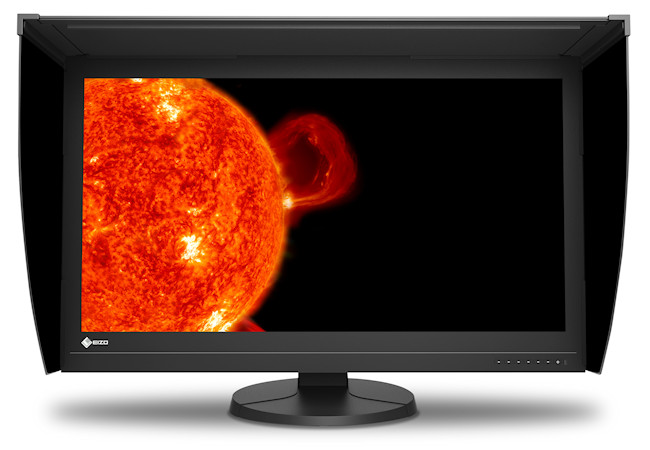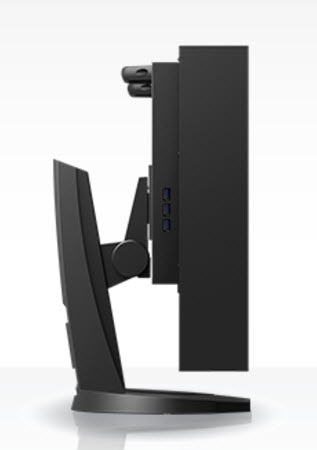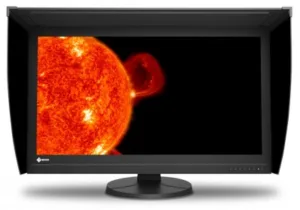Eizo has responded to the need for monitors able to support HDR by announcing the ColorEdge Prominence CG3145 31.1″ DCI-4K reference monitor which has support for 1,000 cd/m² of output and yet also achieves 1,000,000:1 contrast ratio. Eizo said that the contrast is not achieved by local dimming or auto brightness limiting. As a result, it doesn’t have problems with ‘halo’ effects. It uses an IPS LCD panel with 4096 x 2160 resolution.

For HDR purposes, the monitor supports both the PQ and HLG EOTFs and so can be used for video or movie-based content. The monitor has 98% of the DCI-P3 colour space and 99% of AdobeRGB and has a 24 bit LUT to support 10 bit display to avoid banding. A light shielding hood is included (although Eizo doesn’t say if this is for the operator or to protect onlookers!).
Inputs include dual DisplayPort and HDMI inputs as well as USB 3.0 for the hub. Many other features of the monitor are ‘to be decided’.
Analyst Comment
Eizo said that it chose the name ‘Prominence’ to reflect the use of the term as ‘solar prominences’ to describe flame-like eruptions which extend from the Sun’s surface – the brightness of the sun contrasting with the darkness of space.
Pricing has not yet been set as the set is not likely to be shipping until early 2018. Pricing is likely to be ‘competitive with the BVM-X300’ from Sony which means of the order of ‘$25,000’. So why announce the product so early? That’s because it will be shown at NAB this year (and IBC later in the year) as Eizo finally starts to seriously look at the broadcast monitor segment.
Now, the company looks to be in a very good situation in having the only monitor that I am aware of that can offer OLED-like contrast, along with LCD peak brightness. OLEDs typically drop dramatically when the full white screen is shown – a feature that we heard Canon emphasising to a client that said that they loved the contrast of the Sony at the IBC show last year. But Canon doesn’t have the contrast of the OLED.
 So, how does Eizo achieve the high contrast without a halo? We believe that the company must be using a dual modulation approach, with an extra monochrome LCD of full 4K resolution between the backlight and the front panel, although we couldn’t get anybody to formally confirm this at the time of writing (but neither would they deny it!). The panel could be of lower resolution, with just one pixel for each triad on the front panel, I would have thought. As each of the panels can achieve 1,000:1 contrast and the levels multiply together, in total the contrast reaches 1,000,000:1.
So, how does Eizo achieve the high contrast without a halo? We believe that the company must be using a dual modulation approach, with an extra monochrome LCD of full 4K resolution between the backlight and the front panel, although we couldn’t get anybody to formally confirm this at the time of writing (but neither would they deny it!). The panel could be of lower resolution, with just one pixel for each triad on the front panel, I would have thought. As each of the panels can achieve 1,000:1 contrast and the levels multiply together, in total the contrast reaches 1,000,000:1.
This approach is not new as a concept. Several years ago, Sharp showed an LCD with this level of contrast and after some thought, we speculated that a dual panel approach was used. The company wouldn’t confirm, but a Japanese engineer we suggested it to could not resist a smile. Since then, Dolby has used a dual modulation approach when it was developing the PQ curve. However, Dolby used a big projector as the backlight for an LCD. Christie has also developed an HDR projector using dual modulation that Chris reported on.
At one level, using a double LCD should be simple, however, we suspect that there is a lot to learn in delivering a very high level of quality. In that way, it is probably like optical bonding – it sounds simple, but the engineering probably has a lot of ‘wrinkles’. In fact, it wouldn’t surprise me if the knowledge that Eizo will have gained from having its own optical bonding facility had not been very useful.
A double layer of LCD may be a factor in why the display is so deep – it will also need a very powerful backlight to offset all the losses in the optical stack. Power consumption is still TBD.
Eizo has a good number of years of experience in developing custom chips for monitors and we would expect that they can, therefore, deliver a good solution to map HDR and SDR content to the display. It also has very accurate colour control, and we have heard that they recently won a ‘shoot out’ with a significant client brand that cares a lot about colour on the basis of its accuracy. (BR)

